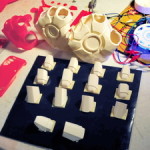“A box that can produce anything.
Take Thomas Lemieux, an Oakland laboratory technician who indulges his passion for Iron Man costumes with an obsessive attention to detail.
Last year he spent hundreds of hours and thousands of dollars building a costume out of foam rubber and electronics that won him awards and acclaim at costume balls, gaming conventions and fairs for innovative do-it-yourselfers.
When Lemieux sat down to plan his second Iron Man suit, which he hopes to finish later this year, he wanted to solve a problem that had confounded him on the first go-round. The painted foam-rubber helmet was too soft and weak for him to install servo motors for a remote-controlled faceplate.
He considered having a hard plastic helmet custom-made by a manufacturing company, but the perfectionist didn’t want to lay out money for a helmet that might be a little off.
“What if you order it and it’s a little too small?” he said.
The problem led him to a technology that some experts say will change the world. Lemieux bought himself a 3-D printer, a MakerBot Replicator 2. It retails for about $2,200, but he found a broken one for $950 and replaced a motor to get it working.
In the same way that a regular printer lays down a layer of ink on a sheet of paper, a 3-D printer lays down a thin layer of plastic on a platform. But while ink printers typically print a single layer and move on, the 3-D printer puts down multiple layers of plastic, causing a shape to rise up out of the platform. When it’s done, it has made a complete object — maybe a cereal bowl or a doorstop or a picture frame.
Or, in Lemieux’s case, an Iron Man helmet.
One in every home
The MakerBot is one of several brands of 3-D printers that have begun marketing their products to consumers such as Lemieux, who have some need or desire for a product that can’t be found cheaply at the local Walmart.
With prices on the machines dipping to as low as several hundred dollars, Chris Bennett, an associate professor of computer science at the University of Maine at Farmington, said the machines will be in almost every home in the state in just 10 or 15 years.
They will penetrate the market in the same way that microwaves, desktop computers and high-definition television sets have, he said.
Gartner, an information technology research firm that pays close attention to technology trends, said in a recent report that the number of 3-D printers shipped worldwide is growing quickly, with consumers expected to spend $133 million on printers this year.
The number of printers grew from about 38,000 in 2012 to about 57,000 in 2013. The research company predicts the number will approach 100,000 this year and double again next year.
Meanwhile, prices are coming down, with low-end models capable of printing small objects about the size of a coffee mug, costing just a few hundred dollars.”
We’re big fans of 3D printing and can’t wait for the technology to be as common as an inkjet printer!
Source: KJOnline





